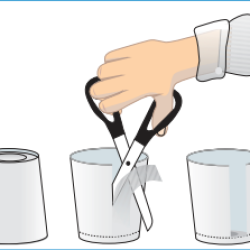Source Institutions
Source Institutions
Add to list Go to activity
Activity link broken? See if it's at the internet archive

In this activity on page 7 of the PDF (Water in Our World), learners make their own water treatment systems for cleaning water. Learners construct two filters to test: one with sand and one with sand and charcoal. Learners compare how well the sand and sand + charcoal filters clean water that is "dirtied" with food coloring, dirt, and grass. This activity also features a list of ten ways you can conserve water. Safety notes: Adult supervision is needed for this activity. Do not drink any of the water samples in this activity. Make sure to follow the safety tips listed on page 3 of the PDF, as well as those listed in the procedure for the activity.
- Under 5 minutes
- 45 to 60 minutes
- $5 - $10 per student
- Ages 8 - 14
- Activity, Experiment/Lab Activity
- English, Spanish
Quick Guide
Materials List (per student)
- water
- measuring cup
- 2 medium, disposable paper cups (8-ounce)
- food coloring (red, green, or blue)
- measuring spoons
- dirt and grass
- wooden craft stick
- fragrant oil (optional; orange or lemon works best)
- 5 small, disposable paper cups (3-ounce)
- ballpoint pen
- 2 cotton balls
- sand (available at a hardware store)
- quarter (25-cent coin)
- metric ruler (15-centimeter)
- activated charcoal (available at a pet store with the aquarium supplies)
- scissors
Subjects
-
Earth and Space Science
-
Earth Structure
- Oceans and Water
-
Earth Structure
-
Engineering and Technology
-
Engineering
- Chemical Engineering
- Environmental Engineering
- Technology
-
Engineering
-
Physical Sciences
-
Chemistry
- Chemical Bonding
- Solutions
-
Motion and Forces
- Gravity
-
States of Matter
- Solids
- Liquids
- Structure and Properties of Matter
-
Chemistry
-
The Nature of Science
-
The Scientific Process
- Conducting Investigations
- Gathering Data
- Formulating Explanations
- Communicating Results
-
The Scientific Process
-
The Nature of Technology
-
Technology and Society
- Impacts of Technology
-
Technology and Society
Audience
To use this activity, learners need to:
- see
- see color
- read
- touch
Learning styles supported:
- Uses STEM to solve real-world problems
- Involves hands-on or lab activities
Other
Foreign language versions of this resource:
Access Rights:
- Free access
By:
- Department of Volunteer Support, American Chemical Society
Rights:
- All rights reserved, American Chemical Society, 2011
